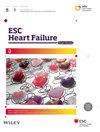Association between NT-proBNP changes and clinical outcomes in paediatric patients with heart failure: Insights from PANORAMA-HF and PARADIGM-HF
Abstract
Aims
The PANORAMA-HF trial demonstrated significant N-terminal pro-B-type natriuretic peptide (NT-proBNP) reductions in paediatric patients with left ventricular systolic dysfunction with sacubitril/valsartan or enalapril treatment over 52 weeks. This post hoc analysis aims to correlate changes in NT-proBNP levels with clinical outcomes in PANORAMA-HF patients receiving either sacubitril/valsartan or enalapril. Additionally, NT-proBNP reductions in the paediatric population were compared with a subset of adult heart failure with reduced ejection fraction (HFrEF) patients from the PARADIGM-HF trial.
Methods and results
This post hoc analysis utilized data from Part 2 of the PANORAMA-HF trial. Associations between baseline NT-proBNP levels, changes post-baseline and the risk of HF clinical events in paediatric patients on sacubitril/valsartan or enalapril were assessed. The paediatric HF population from PANORAMA-HF was categorized into age groups (AG): AG1 (aged 6 to <18 years), AG2a (aged 2 to <6 years) and AG3a (aged 1 month to <2 years). The Cox proportional hazard model evaluated the relationship between NT-proBNP and clinical outcomes. Analysis of 361 paediatric patients (sacubitril/valsartan, n = 179; enalapril, n = 182) demonstrated overall higher baseline NT-proBNP levels in younger AGs. At Week 52, both treatment groups exhibited reduced NT-proBNP levels across all AGs. Reductions were comparable between sacubitril/valsartan and enalapril, with a numerically greater reduction observed in adult patients versus children. Strong associations between NT-proBNP levels and HF clinical outcomes were observed in paediatric populations in PANORAMA-HF and in adult DCM patients with HFrEF in PARADIGM-HF. Doubling of NT-proBNP levels was associated with a ≥1.7-fold increased risk of HF clinical events, while halving of the levels correlated with a 52% reduction in the risk of clinical events.
Conclusions
This is the first prospective, randomized large-scale study to demonstrate a strong correlation between NT-proBNP levels and risks of HF clinical events in paediatric patients with HF.


 求助内容:
求助内容: 应助结果提醒方式:
应助结果提醒方式:


